Michelangelo Drawings: Real or Fake?
March 4th, 2006essay
This drawing is “one of Michelangelo’s most celebrated works in the British Museum.”1 But did Michelangelo draw it?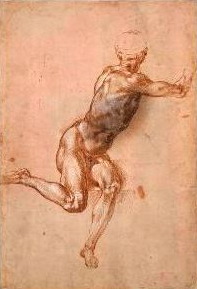
The Michelangelo Drawings exhibition (British Museum through 25 June) is an important historical event. The exhibition assembles a large collection of drawings from different museums, drawings that have not been presented side-by-side in centuries. The subtle aspects of drawing — such as technique, materials, and paper, cannot be properly studied from photographs. Thus, the Michelangelo Drawings exhibition is a unique opportunity for us to interpret, or reinterpret, Michelangelo’s work.
One critical aspect in interpreting Michelangelo’s drawings is deciding what is a genuine Michelangelo. The drawings on display provide an excellent opportunity to study this problem. In addressing this topic, however, the exhibition itself is weak. Visitors to the exhibition are shielded from this problem for the most part, because it receives scant attention in the exhibition audio guide and information pamphlet supplied to each visitor (as I experienced at the Michelangelo Drawings exhibition when it was recently at the Teylers Museum in Haarlem, The Netherlands). The label on many drawings, “Michelangelo Buonarroti”, conveys a false sense of certainty to the average visitor. The issues of attribution and authenticity are indeed discussed in the book accompanying the exhibition, Michelangelo Drawings: Closer to the Master by Hugo Chapman, for the small minority of visitors who will both buy the book and read it carefully. But even here, the issue is dealt with more in a ceremonial way than a functional one. Hugo Chapman, a curator of drawings at the British Museum, does a good job discussing the issues involved in deciding on a drawing’s authenticity (his writing in many respects is similar to the analysis I made independently before reading his book). However, there is little or no attempt to apply these ideas to judging the authenticity of specific drawings in the current exhibition. Given the opportunities for a fresh perspective that the exhibition presents, this is a missed opportunity.
“Real” or “Fake”?
How do we make decisions about “real” or “fake” for a large number of drawings? The first concept that we need is a way to deal with uncertainty. This is what the exhibition lacks. A systematic way to approach the issue is to assign to each picture a probability that it is a “real” Michelangelo. For example, we might say that we believe there is a 95% chance that each drawing in the exhibition is correctly attributed to Michelangelo. That is a high degree of certainty for any given drawing, perhaps enough to bet your life on — once or twice. And yet, because there are so many drawings, we must expect that several of them should be fake — although we would not know which ones. This is what we mean when we say that each drawing has a 95% chance of being “real” — each drawing also has a 5% chance of being “fake”. As a consequence, you wouldn’t want bet your life that every picture is “real” because, with a good chance, you wouldn’t survive.
Where did I get this number, 95%? At this point, it is only for the sake of the example. In the real exhibition, all of the drawings are different — in a variety of ways, and thus for each drawing we should make a separate assessment of the chance that it is “real”. This brings us to the question, how do we choose a percentage chance of being “real” for each drawing?
Factors in Judging a Drawing
Although there are many subjective elements in judging a drawing, we can identify important objective factors to guide our decision-making.
1. Michelangelo’s materials and style
To begin with the most obvious, consider something every drawing has in common — they are all on paper.
Handmade paper is a rich topic that one could spend a lifetime studying. The Michelangelo exhibition is a feast for the paper-maker. Every sheet of hand-made paper is, of course unique, although this can only be appreciated by looking at the paper in real life, not in photos. By looking at every sheet in the exhibition, it is possible to get a sense of what types of paper Michelangelo normally used. There are perhaps two or three distinct, though subtly different, styles of paper that an expert would identify as commonly used by Michelangelo. For the most part, Michelangelo seems to have been conservative in his choice of paper — fairly smooth, fairly white — that is what he chose.
As any paper-maker (or money-forger) knows, it is difficult to duplicate a sheet of paper made by another paper maker. And if the other paper maker lived five-hundred years earlier and had different tools and materials, the task of making a duplicate becomes nearly impossible.
What if we find a drawing in the exhibition on paper that is somehow distinct from all the other papers? Since we see that Michelangelo was conservative in his choice of papers, and since we also know that to replicate those papers is difficult or impossible, the distinctive paper may be a clue that the drawing is “fake”. Could Michelangelo have used an unusual sheet one day? Of course! But when we look at his work today, and see what survives, we would be foolish not to consider the possible significance of an unusual sheet of paper.
Given a sheet of paper, Michelangelo had to draw with something. Black and red chalk were his most important drawing media. Michelangelo’s black chalk drawing technique has a signature quality, an etherealness, whether he worked with lines and hatching, or utilized blending and smearing. Where a drawing departs from Michelangelo’s signature qualities, we can be suspicious. Is this to say that Michelangelo could not have departed from his own characteristic styles now and then? Of course not! It is merely to say that a difference in style from the norm necessarily affects our judgment of the authenticity of a drawing. His red chalk drawing technique is also unique and sublime.
Michelangelo drew with pen, although apparently less often than with chalk — at least in the drawings that survive. Despite the enthusiasm of the museums that contributed to the show, Michelangelo was not the greatest of masters with pen and ink — at least judging by what is in the exhibition. Leonardo da Vinci was far his superior in this medium. The relative scarcity of Michelangelo’s pen drawings presents a problem — it becomes difficult to get an idea of what his normal styles were, and therefore, it becomes more difficult to judge if a pen and ink drawing is “real”. Therefore, pen and ink drawings are necessarily more difficult to be confident in than chalk drawings.
Michelangelo not only drew, he drew with passion. He filled a sheet of paper with drawings, then used another sheet to continue with the same idea or study. And then another. What this means is that we can often judge the drawings in relation to one another, especially in the case of a series of drawings on the same topic. If there is a series of drawings, and all the drawings seem to be connected in subject and style, it makes us more confident that the drawings are “real”. For an isolated drawing that we cannot compare to anything else, or a drawing that is related to a series but somehow does not fit in, it is necessarily more difficult to develop a high degree of confidence as to its authenticity.
For example, most of Michelangelo’s early drawings are lost. Thus, the isolated examples that survive — at least as far as the attributions go — are necessarily of less certainty. It would be the same if we had one wood carving attributed to Michelangelo. It might be good, but how could we judge it?
Sometimes Michelangelo re-used sheets that had older drawings, an indication that he was so focused on his work that he used whatever paper was at hand, rather then searching for a fresh clean sheet. In such a case, where both older and newer drawings seem authentic, it becomes easier to have confidence in the drawing as a whole being “real”.
2. Opportunities for a copy or forgery
So far, we have focused on Michelangelo as a creator of drawings. However, in his time, and since then, there have been tens of thousands of other artists who wished to study, emulate, copy, or forge his work. This presents an enormous problem when it comes to judging whether a given drawing is a “real” Michelangelo. The best example of the problem is with his fresco cartoon for the Battle of Cascina. Here is what Michelangelo’s contemporary, the artist and art historian Giorgio Vasari, had to say about it:
When it [the cartoon] was shown, many said that such a thing had never been seen before, either from his [Michelangelo’s] hand or another’s. And indeed this must be true, for all who have studied this cartoon have become men excellent in the art. And because it became thus a study for artists it was carried to the Medici palace, and was left in too great security in the hands of the artists. For during the sickness of [the Duke], when no one was thinking of the matter, it was torn and cut into many pieces, and dispersed in many places.
Here then we are dealing with a major drawing by Michelangelo, a drawing which we can no longer see. Before he made the cartoon, Michelangelo certainly made a huge series of studies for it, some of which are said to be in the exhibition. But after he made the cartoon, it was studied by many other artists. And because it was a drawing, other artists of the time could copy it in exactly the same medium — black chalk — and presumably on the same type of paper. They could also have copied it in other media, such as pen and ink. The key point is that there would be no need to translate from the language of painting or sculpture into the language of drawing when making a study of the cartoon. In a technical sense a drawing is more accessible to an artist than is a more complete work in paint or stone — despite the fact that complete works are what is normally on display. This is likely one reason why the cartoon was such an attraction for artists to study when they had the opportunity
Thus, the Battle of Cascina cartoon was a high-circulation drawing, with many opportunities for artists to copy it. Presumably there were also copies of the copies. The original is lost, so we cannot be certain what Michelangelo in fact created, although a painted copy of it survives which gives an idea of the full composition. The question then arises, what are we to think of any surviving drawings that are related to the Battle of Cascina?
The answer is, because of the historical context, we must view these drawings with extreme suspicion.
With other drawings, it also makes sense to consider their historical contexts, and these were sometimes very different from the Battle of Cascina example. Was a drawing one that many artists could have seen, or was it likely viewed by very few people over the centuries? These considerations need to be taken into account when we judge whether a drawing is “real” or “fake” — that is, the opportunities that were available to make a copy or forgery.
3. The difficulty of making a forgery
Let us imagine that someone wanted to make a forgery of a Michelangelo drawing. How hard would it be? We have already discussed Michelangelo’s paper and materials. To duplicate these becomes more and more difficult as time goes on. Suitable natural black chalk for drawing is extremely scare nowadays, as is good handmade paper. In earlier times, this would have been less of an obstacle. Then there is the problem of imitating Michelangelo’s style. Even if someone could copy directly from an original, the task would be difficult. The level of difficulty would of course depend on the quality of the original drawing. If Michelangelo made a rough sketch, which he seems to have often done, this would be far easier to copy than a refined work. This then is another factor to consider when judging an individual drawing: how difficult would it be to copy, based on its complexity and subtlety? For every drawing, the answer would be different.
Analysis of Specific Drawings
1. The Battle of Cascina
Now that we have a set of factors for considering whether a drawing is “real” or “fake” we can begin to judge some drawings from the exhibition. Let us begin with the Battle of Cascina.
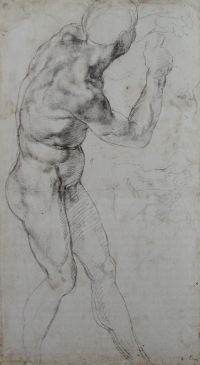
In the exhibition are two drawings, A male nude and A male nude, of figures, made in black chalk, that tie directly to the missing cartoon. In material — paper and chalk — they are consistent with Michelangelo’s practice. But because we know the final cartoon was studied when it was first displayed in Florence, the match in materials is not so helpful in judging the authenticity of the drawing — since other artists would have had access to the same materials. A factor in favor of both drawings is that they show, schematically, parts of the figures that would have been invisible in the final cartoon — because of the tangle of figures in that work. Thus, an artist making a copy of the final cartoon would necessarily have had to put in details not in the cartoon, if he were to make these single-figure drawings. 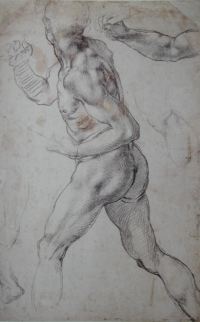 Also, both figures in the exhibition lack defined hair, whereas in the final cartoon they seem (judging from the copy by Bastiano da Sangallo) to have thick, even wavy hair. Thus, an artist making a copy of the cartoon would have had to deliberately leave out these details. Both of these factors — the extra details, and the details left out — argue against these drawings being direct copies from the original cartoon. Moreover, on the back of the first drawing, there is another drawing that is likely a Michelangelo original — an early compositional sketch for the Sistine chapel. The second drawing likewise has a probable Michelangelo drawings on the reverse side.
Also, both figures in the exhibition lack defined hair, whereas in the final cartoon they seem (judging from the copy by Bastiano da Sangallo) to have thick, even wavy hair. Thus, an artist making a copy of the cartoon would have had to deliberately leave out these details. Both of these factors — the extra details, and the details left out — argue against these drawings being direct copies from the original cartoon. Moreover, on the back of the first drawing, there is another drawing that is likely a Michelangelo original — an early compositional sketch for the Sistine chapel. The second drawing likewise has a probable Michelangelo drawings on the reverse side.
Even more important than any of these factors, however, is the factor of style. Both drawings are masterpieces of draftsmanship, both of them contain what we regard as Michelangelo’s signature technique. To make such remarkable drawings, even copying from an original, would be very difficult. Very difficult, but not impossible. Putting the various factors together, I assign a 98% chance that each drawing is original. If not for the odd historical context, I would be even more certain.
To continue with the Battle of Cascina, let us now consider the pen and ink drawing of a male figure, A seated male nude twisting around.  This drawing was selected as the cover of the English edition of the exhibition catalogue, Michelangelo Drawings: Closer to the Master. But is it “real”? Let us consider the factors for judging a drawing.
This drawing was selected as the cover of the English edition of the exhibition catalogue, Michelangelo Drawings: Closer to the Master. But is it “real”? Let us consider the factors for judging a drawing.
First of all, the paper: it is different from most of the other papers in the exhibition. It is darker. This may be related to the technique of the drawing. It is a refined pen and ink drawing with crisp lead white highlights painted with a brush. This combination of techniques, for a figure drawing, is unique in the exhibition. It is by no means an odd choice of materials and technique, but it is not typical of Michelangelo’s surviving work. This must command our attention.
What else? The drawing is unusual in that it shows a nearly complete figure. In every other study drawing for a fresco or sculpture attributed to Michelangelo in the exhibition, the figures are incomplete in some way. They lack a head, or arms, or legs, or, if these are present, they are often in a schematic form that is characteristic of Michelangelo. When making a study for a larger work, Michelangelo seems not to have made complete refined drawings of the figures. That makes A seated male nude twisting around distinct1.5. It differs in another way as well. Michelangelo’s studies, regardless of how refined, are typically not alone on a sheet. He almost always draws further studies on the same page — perhaps a larger version of the head, or hands, or legs. And yet in A seated male nude twisting around, a big sheet, there is one figure, with no surrounding studies, only a lot of empty paper. This is atypical of Michelangelo.
Then there is the hair. The hair and head-dress of the figure somewhat resembles that of the final cartoon. This sets it apart from his other studies for the Battle of Cascina and other works, where the hair is not developed at all.
Then, consider the question of style. The drawing is indeed a fine work. But is it a great figure drawing? It has some notable flaws. The figure’s left leg is awkward and too small, the buttocks are not elegant in form. Can we relate it in technique to another figure drawing in the show? The answer is no.
And the reverse side of the drawing? Here, although not visible in the exhibition or in the catalogue, there are nude studies in red chalk — drawings “not by Michelangelo” in the judgment of curator Hugo Chapman. Michelangelo normally drew on his own paper. Sometimes his students made related studies besides his work on the same sheet; but for Michelangelo to make a complete drawing on the reverse of another artist’s unrelated work is to, say the least, unusual.
All of the factors taken together suggest that this is not a “real” Michelangelo, but a copy from the final cartoon by another artist. The nearly complete figure, the suggestion of hair and head-dress, the uncluttered page, the drawing and painting media, all point towards a copy from the final work, rather than a study by Michelangelo. This drawing seems to have only two factors in favor of it being “real”: that it is a good drawing, and that it is related to the Battle of Cascina. Neither of these factors is compelling, given of the historical context of the cartoon. Are we to believe that there were no other talented artists in Florence who could have made this drawing, or made one from which this one was copied? What about Lenoardo da Vinci himself, or one of his pupils, or Raphael, or one of the others that Vasri refers to as being “men excellent in the art” who studied the Battle of Cascina cartoon?
I give the drawing only a 10% chance of being a “real” Michelangelo.
2. Studies for ‘Day’
Let us turn now to drawings with a very different historical context, the seven studies Medici chapel: Seven studies after a nude model for Day (e.g. Study for ‘Day’) of a male figure for the marble sculpture of Day on the Medici tomb in Florence. 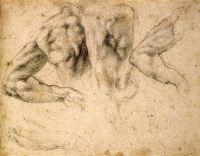 These drawings constitute a series because they have the same subject, the same materials, the same style. The drawings are magnificent examples of draftsmanship. They are studies of parts of the body, or incomplete figures, some with multiple studies on a page — all typical of Michelangelo. These drawings were likely seen by very few people over the centuries. Thus, there would haven been limited chance for copies or forgeries to be made. True, someone could have made these drawings working from the finished marble sculpture — but this would require a difficult process of translation, from the language of sculpture into the language of drawing, and specifically into Michelangelo’s particular dialect of drawing. All of these factors give us a high degree of confidence that the drawings are “real”. One factor against the drawings is that they are relatively simple. If someone had access to the original drawings and wished to copy them, these would not be the most difficult of Michelangelo’s drawings to reproduce. However, I think the chances of this are slim. I assign to each drawing a 98% chance of being “real”.
These drawings constitute a series because they have the same subject, the same materials, the same style. The drawings are magnificent examples of draftsmanship. They are studies of parts of the body, or incomplete figures, some with multiple studies on a page — all typical of Michelangelo. These drawings were likely seen by very few people over the centuries. Thus, there would haven been limited chance for copies or forgeries to be made. True, someone could have made these drawings working from the finished marble sculpture — but this would require a difficult process of translation, from the language of sculpture into the language of drawing, and specifically into Michelangelo’s particular dialect of drawing. All of these factors give us a high degree of confidence that the drawings are “real”. One factor against the drawings is that they are relatively simple. If someone had access to the original drawings and wished to copy them, these would not be the most difficult of Michelangelo’s drawings to reproduce. However, I think the chances of this are slim. I assign to each drawing a 98% chance of being “real”.
3. Studies for The Last Judgment
There are several studies of figures for the Last Judgment fresco in the Sistine Chapel in the exhibition. All of them are consistent with each other and with Michelangelo’s other work in terms of style, material, and technique — all except one drawing, Last Judgment: A flying angel and other studies.
If the drawing A flying angel and other studies were “real”, it would likely be a low-circulation drawing, seen by few people over the centuries.  This would mean that few people would have the opportunity to copy it. And yet, despite this favorable historical context, there are troubling things about the drawing.
This would mean that few people would have the opportunity to copy it. And yet, despite this favorable historical context, there are troubling things about the drawing.
Let us consider the overall aesthetic quality. In this respect, there is something obviously wrong with this drawing. It is a large, complex and refined drawing of dramatic figures for The Last Judgment. It should by all rights be one the the best drawings in the exhibition. And yet, it is somehow empty, without soul. This is not only my impression. In the exhibition pamphlet, we read “The shading and modeling seem mechanical, and the contours are flat, doing little 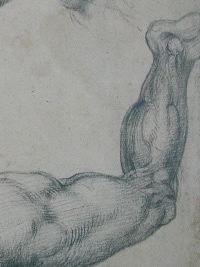 to suggest the curves of the body.”
to suggest the curves of the body.”
Aside from these aesthetic factors, there are the following points against the drawing:
First, the use of the black chalk is hard and sharp, in a manner different from every other example of Michelangelo’s chalk drawings in the exhibition, which normally show a sublime softness and ethereal quality, whether he worked with simple lines and hatching, or used extensive blending and smearing of the chalk to create atmosphere.
Second, in the five other refined figure drawings for The Last Judgment (e,g, A male nude seen from behind), 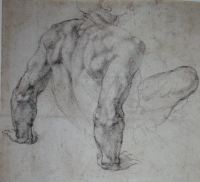 Michelangelo uses a special technique to indicate highlights on the figures — he makes little circles with black chalk. This is a symbolic rather than an graphic technique, because he did not use white pigment on the light paper to indicate highlights. However, in A flying angel and other studies, there are no marks like this to indicate the areas of highlight.
Michelangelo uses a special technique to indicate highlights on the figures — he makes little circles with black chalk. This is a symbolic rather than an graphic technique, because he did not use white pigment on the light paper to indicate highlights. However, in A flying angel and other studies, there are no marks like this to indicate the areas of highlight.
Third, the paper is different from any other sheet in the exhibition. It has a fine, distinct network of wrinkles that is characteristic of some old papers, but not of Michelangelo’s. I found only one example of paper that had similar surface texture in the exhibition. It is not from a Michelangelo drawing, but rather in the form of small pieces of paper used by a restorer of drawings for the Sistine Chapel ceiling (two sides of a single sheet) to fill holes where the original paper was lost when the sheets were cut into pieces. This illustrates the difficulty in matching Michelangelo’s normal drawing paper, even for an expert at restoration
How do we explain all of these odd coincidences? One explanation is that picture A flying angel and other studies is a forgery, in the classic sense of the word — that is, a drawing made from an original for the specific purpose of creating a valuable counterfeit. We can never be certain A flying angel and other studies is a fraud. It could also be an innocent copy of a Michelangelo drawing, now lost. For whatever purpose it was made, the various factors I discuss reduce the chances of the drawing being “real” — in my estimate, to only a 15% chance.
Analysis of the Entire Exhibition
I have looked at each drawing attributed to Michelangelo in the exhibition (at the Teylers Museum) and given it a percentage chance of being “real”, following the approach I described in the examples above2. For my analysis, I only considered drawings that have been attributed to Michelangelo alone; I leave out all drawings which are considered to have contributions by pupils. This leaves me with a total of 97 drawings listed in the exhibition when it was in Haarlem. [Some drawings were made on opposite sides of a single sheet, so the number of pieces of paper in the exhibition, with drawings attributed to Michelangelo alone, is fewer than 97. The London exhibition has even more drawings.]
Using my percentage ratings and the simplest of statistical calculations, we can ask some interesting questions. For example, what is the probability that the entire exhibition is a fraud? My calculations show that the probability of that is very very low, almost zero. You can be certain that there are a good number of “real” Michelangelo drawings in the exhibition.
On the other hand, what is the probability that every drawing attributed to Michelangelo was correctly attributed? There is only a small chance of that, approximately one in fifty-thousand. Thus, it is reasonable to expect that there is at least one “fake” in the exhibition.
Finally, how many of the 97 drawings attributed to Michelangelo in the exhibition would we expect to be misattributed, from a simple statistical calculation? According to my assessment, the number [expected value] is approximately eight.
From my analysis, the eight most doubtful pictures are:
A seated male nude twisting around 10%
Last Judgment: A flying angel and other studies 15%
Three figures in adoration 75%
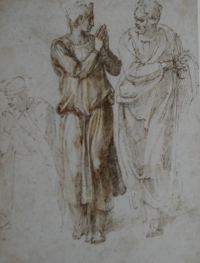
Two figures leaning forward 75%
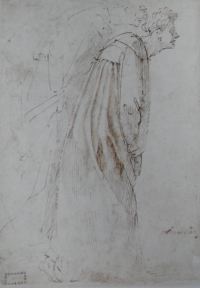
Head of a man in profile 75%

Sketch for a battle-scene 75%
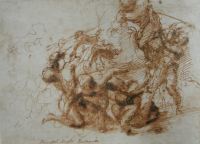
Study for the drapery of the ‘Erythraean Sibyl’ 75%
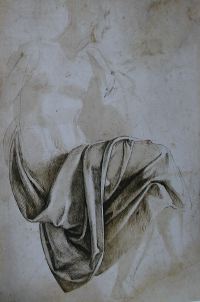
Christ at the column 75%
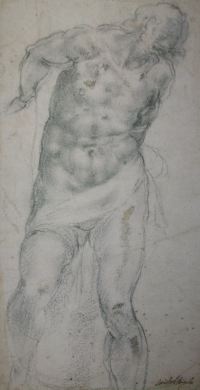
Except for the first two in the list, the remaining six drawings have a reasonably good chance of being authentic. The main thing that lowers confidence is that, for the third through sixth, these are isolated pen drawings for which it is difficult to make stylistic comparisons to other work. The drapery study for the Erythraean Sibyl is very likely connected to work on the Sistine Chapel; however, it is an aspect of the project that could have been left to a competent assistant. Christ at the Column is a drawing made for a collaborative project with a painter; it is possible that this drawing was made by the collaborator, working from an original Michelangelo; although, as the 75% confidence rating suggests, the chance of that is not large.
We must remember that statistical calculations only tell us what is most likely (and then only if we asses the probabilities correctly.) They do not give us certainty. It is indeed possible that all eight of the drawings listed above are “real”, and that some others are copies or frauds. The point is that, although we might not know with certainty which are the “fake” drawings, given the probabilities I assigned to each drawing — with the various factors for judging drawings in mind as described above — the laws of probability say we should expect there to be eight “fakes”, more or less. The situation is akin to the imaginary example I gave earlier, where each drawing had a 95% chance of being “real”; the only difference is that now I have assigned each picture a separate chance of being “real”2. In fact, 95% was the most common assignment that I made for drawings in the exhibition. Some pictures had higher ratings, as described earlier, whereas the eight listed above had the lowest ratings.
One might argue that it is impossible that there are eight, or anything near eight, misattributed pictures in the Michelangelo Drawings exhibition. If one takes this position, it is equivalent to saying that one has a much higher confidence estimate for the individual drawings than I have made. That is not unreasonable. But for the most part, my confidence ratings are quite high. I doubt if even the museum curators would argue with most of the numbers.
Conclusion
In the past, art forgery was something like what computer hacking is today Just as some computer experts seek the thrill and financial rewards of breaking into secure computer systems, so in the past, some artists sought the thrill and rewards of passing off their own work as that of a great master. Historical circumstance and technological change combine to make art forgery more difficult, and they make computer hacking possible. But human nature, and the quest for thrill and gain, these remain the same. Therefore, when examining any old drawing, one must keep in mind the question, “Could this be a fraud, if a competent artist used all his or her abilities to create a replica of a master’s work?” And of course, we must also consider possibility that innocent copies were later mistaken for originals by collectors. If by magic we could know the answer to the great question, “Real or Fake?” we might be in for some big surprises.
Eight “fake” Michelangelo’s among 89 “real” ones is not bad by any means, if that is indeed what we saw at the Teylers Museum’s hosting of Michelangelo Drawings exhibition. But in my opinion, the museum could have given the public better warning of the uncertainty, and encouraged visitors to make decisions for themselves. Hopefully the exhibition in London will correct this flaw.
I encourage every visitor to an exhibition in London to be a detective, to make his or her own judgments. Look at the pictures carefully. The clues are waiting for you.
Notes
1 Michelangelo Drawings: Closer to the Master, p. 30. This drawing is on the cover of this book, and until recently was also the main promotional drawing for the coming exhibition in London.
1.5 [update 12 April 2006] The right hand is not drawn in A seated male nude twisting around. This part of the figure was obscured by another figure in Michelangelo’s original fresco cartoon (judging from surviving copies of the scene). That is to say, the missing hand is a part for which a copyist would have had nothing to copy. In contrast, when Michelangelo drew his studies, he would often make a highly simplified representation of areas like this (an outline of the hand, for example). Thus, A seated male nude twisting around is odd in these two complementary respects: it is simultaneously more complete and less complete than other comparable Michelangelo drawings made for frescos.
In A seated male nude twisting around, the left hand is not drawn at all, although it was apparently depicted in the fresco cartoon, in shadow of the torso.
Although Michelangelo’s figure studies (generally guessed to be from live models) are characteristically incomplete, the artist often drew complete figures in a different context — compositional drawings such as the Fall of Phaeton. These drawings are different from figure studies because they represent not studies of bodies so much as studies of scenes, often with multiple figures. It is generally agreed that these are not direct life studies, although the figures may be based on life studies.
2 The following is a list of the drawings I rated, in the sequence they appeared in the exhibition. The number before each title is my percentage confidence that the drawing is correctly attributed to Michelangelo. I leave out all drawings that are already considered to be copies, or to have contributions by students, in order to focus on what are considered to be “pure” Michelangelo drawings.
- 75% Three figures in adoration
- 75% Two figures leaning forward
- 85% An old man wearing a hat
- 75% Head of a man in profile
- 95% Sketch for a battle-scene; two figures
- 75% Sketch for a battle-scene
- 10% A seated male nude twisting around
- 95% A youth beckoning; a right leg
- 95% A group of three nude men; ‘the Bruges Madonna’
- 95% Male nudes, two putti and a left leg
- 98% A male nude
- 98% A male nude
- 98% Compositional sketch for ‘Judith and Holofernes’
- 75% Study for the drapery of the ‘Erythraean Sibyl’
- 98% Study for a seated male nude (‘ignudo’)
- 98% Studies for God the Father and attendant angels (‘Creation of Adam’) and ‘ignudi’
- 98% Study for Adam (‘Creation of Adam’)
- 98% Study for the hand of God, angels (‘Creation of Adam’) and a knee (‘ignudo’)
- 98% Studies of a male head (‘ignudo’) and limbs of God (‘Creation of Adam’)
- 98% Studies for the ‘Crucifixion of Haman’
- 98% Studies for Haman (‘Crucifixion of Haman’)
- 98% Study for St. Lawrence
- 98% Male nude seen from behind
- 15% A flying angel and other studies
- 95% Study of a male nude seen from behind
- 98% Compositional sketch
- 95% Two heads, small figures
- 98% Study of a male nude
- 98% Study for a condemned sinner
- 98% Study for a fighting angel
- 95% Scheme for the Sistine chapel ceiling; studies of arms
- 95% Sketches for the ‘ignudi’
- 98% Studies for a putto and a right hand (‘Libyan Sibyl’) and for the ‘Julius tomb’
- 90% Sistine sketchbook
- 95% Sistine sketchbook
- 85% Sistine sketchbook
- 90% Sistine sketchbook
- 95% Sections through the dome of St. Peter’s, design for the lantern, figure studies
- 95% Ground plan of the lantern’s base, figure studies
- 80% Study for a portal
- 95% Design for a window
- 95% The flagellation of Christ
- 75% Christ at the column
- 95% Lazarus
- 85% Lazarus
- 97% The Risen Christ
- 97% The Resurrection of Christ
- 97% The Risen Christ
- 98% The ‘Fall of Phaeton’
- 95% The Virgin and Child
- 95% Studies for a double wall tomb
- 95% Studies for a single and a double wall tomb
- 95% Studies for a free-standing tomb
- 95% Study for a double wall tomb
- 95% Study for a single wall tomb
- 95% Marble block diagram for a River God
- 98% Study after a nude model for ‘Day’
- 98% Study after a nude model for ‘Day’
- 98% Study after a nude model for ‘Day’
- 98% Study after a nude model for ‘Day’
- 98% Study after a nude model for ‘Day’
- 98% Study after a nude model for ‘Day’
- 98% Study after a nude model for ‘Day’
- 90% Façade of San Lorenzo: Studies of classical architecture
- 90% Façade of San Lorenzo: Studies of classical
architecture - 95% Biblioteca Laurenziana: Two designs for a door
- 95% Biblioteca Laurenziana: Two designs for a door
- 95% Studies for the ‘Dying Slave’ and of flayed arms
- 98% Elevation of parts of the lower story of the Julius tomb
- 98% Elevation of parts of the lower story of the Julius tomb
- 95% ‘Testa ideale’
- 95% Head of a man in profile
- 95% The Worship of the Brazen Serpent
- 95% Portrait of Andrea Quaratesi
- 85% Four grotesque heads; Hercules and Antaeus
- 85% The Three Crosses
- 90% Studies for a Deposition
- 90% Study of a reclining male nude
- 95% The Holy Family
- 95% The Virgin Annunciate
- 95% The Annunciation
- 95% The Lamentation
- 85% Studies for a Crucified Christ
- 95% Crucifixion
- 95% The Crucifixion with two mourners
- 95% The Crucifixion with the Virgin and St. John
- 95% The Crucifixion with the Virgin and St. John
- 98% ‘Countess of Canossa’
- 95% Design for a salt-cellar
- 95% Head of a child
- 95% Aeneas with Ascanius, summoned to leave Dido,
architectural studies - 95% Carrying of Christ to the Tomb
- 95% Studies of two fighting men and of ‘Christ Purifying the
Temple’ - 95% Three studies for ‘Christ Purifying the Temple’
- 95% Three studies for ‘Christ Purifying the Temple’
- 95% Three studies for ‘Christ Purifying the Temple’
- 85% The risen Christ appearing to his mother
To make a mature joint analysis of the probabilities I list here would be very complex. The reason is that all of the decisions about probabilities are dependent on one another. We can only think about Michelangelo’s paper, drawing materials, and style in terms of what we see in drawings that we think he made. My numerical analysis is not a mature one, but one that ignores many complications in order to simplify the calculations. It is a rough, first version of the process of making statistical judgments about the drawings.
For the 97 drawings listed above (some of which are on opposite sides of the same sheet):
the Mean (average) confidence level is 92%
the Median confidence level is 95%
The probability that all the drawings are by Michelangelo is only 1 in 50000, a small number.
The Expected number of false attributions is 8.
The probability that no drawings are by Michelangelo is so small as to be indistinguishable from zero.
References
Cennini, Cennino. Il Libro dell’Arte. The Craftsman’s Handbook. Trans. Daniel V. Thompson. New Haven: Yale University Press, 1933.
Chapman, Hugo. Michelangelo Drawings: Closer to the Master. London: The British Museum Press, 2005.
Vasari, Giorgio. Lives of the Painters, Sculptors, and Architects. Trans. Gaston du C. de Vere. 2 vols. London: Everyman’s Library, 1996
Notes on images
Drawings displayed in this essay under “fair use” pending approval from museums:
A male nude
Black chalk with
white lead highlights on paper
c. 1504-5
The Teylers Museum, Haarlem
A male nude (#2)
Black chalk with
white lead highlights on paper
c. 1504-5
The Teylers Museum, Haarlem
A seated male nude twisting around
Pen and brown ink, brown and grey wash, heightened with crisp lead white strokes (partly discolored) over leadpoint and stylus
c. 1504-5
The British Museum, London
Study for ‘Day’
Black chalk on paper
c. 1524-5
The Teylers Museum, Haarlem
A flying angel and other studies
Black chalk on paper
c. 1534-6
The British Museum, London
A male nude seen from behind
Black chalk on paper
c. 1539-41
The British Museum, London
Three figures in adoration
pen and brown ink on paper
c. 1495-1500
The Teylers Museum, Haarlem
Two figures leaning forward
pen and ink on paper
c. 1495-1500
The Teylers Museum, Haarlem
Head of a man in profile
Pen and brown ink on paper
c. 1500-5
The British Museum, London
A battle-scene
Pen and brown ink on paper
c. 1504
The Ashmolean Museum, Oxford
Study for the drapery of the ‘Erythraean Sibyl’
Black chalk, pen and brown ink and brown wash, lead white highlight on paper
c. 1508-9 The British Museum, London
Christ at the Column
Black chalk heightened with lead white on paper
c. 1516
The British Museum, London
Acknowledgments
I thank Robert Pittman for valuable comments on this essay.
September 9th, 2006 at 2:07 am
I’m totally impressed, Zip. And that’s saying something for me. It’s an important look at an important question. I’ll stick my neck out and say
I think you may be overly generous in putting a 10% authenticity rating on the Seated Male drawing. Who ever did it was a lousy artist and knew
nothing about the human body. The entire area including the hip and buttocks is completely wrong, wrong WRONG ! If I recall correctly,
Michaelangelo was an absolute fanatic about getting the bone structure and muscle structure of his nudes correct. To the point that he invaded the
morgues and hospitals at night to cut open the bodies of corpses to study how the human body is put together. No one who did THAT would be guilty of the “Seated Male” atrocity.
One aspect of the question remains a puzzle for me. Where have these drawings been for the last 500 years ? Who had them ? Who protected them from wear and tear. Who kept them dry and insured that the air and the humidity did not turn them to dust ? Things like this don’t just “turn up” Being a skeptic, I fully expect that in four or five years, after the present puffery surrounding them has subsided, all these drawings NOT positively identified as fakes will be up for sale at bloated prices. And when they’re sold. a second batch of Michaelangelo’s drawings or etchings or sketches or paintings or carvings or doodlings will be discovered and the whole process will begin again. After all, as far as art dealers are concerned there’s a sucker born every minute.
Regards, Bill
September 9th, 2006 at 2:08 am
Hi Bill,
Thanks for the comments. The original drawing looks good from close up,
but the anatomical problems become more evident when you look at a
small version of the drawing (as on my home-page) where the impressive
pen shading is not evident. Here you can focus on the overall form, and
see how awkward it is. As for the origin of the drawing, it is said to
come from the Casa Buonarroti in Florence. To some art historians (for
example the drawings curator at the Teylers Museum in Haarlem), this is
an important factor to consider for the attribution (he said this in a
newspaper article about my essay). However, not all drawings collected
by Michelangelo’s relatives were by Michelangelo. Many drawings left
the Casa Buonarroti in the 18th & 19th centuries. From Hugo Chapman’s
book, ‘Michelangelo Drawings: Closer to the Master’, it seems a bit
vague if the pen and ink drawing in question even came from the Casa
Buonarroti.
-K
September 9th, 2006 at 2:09 am
Zipsters document has to be based upon judgement
alone, just as, in the end, proof of originality will be.
The document is full of things like:
“the possible significance of an unusual sheet of paper.”
“They could also have copied it in other media, such as
pen and ink”
That’s all fine so long as no-one makes the mistake of
assigning any more to it than that of an opinion. That
opinion may be of significance, I do not make any
comment upon that.
We can’t dig Michelangelo up and ask him, and as far
as I know, there is no technology which will provide
answers.
It’s probable that all provenance depends upon agreed
opinions of experts. Once you have proved the material
could have been available at that time, then what else can
be proved?
Some experts have accepted there is a case to be answered,
and if you had accessed the review file I posted, you would
have heard people with no axe to grind accepting that at
least some of the drawings might not be of Michelangelo.
That exhibition by the way, was gathered based upon one
experts opinion.
Bill,
Your comments upon the source of the drawings may be
a little over the top. An important exhibition would not be
willing to accept a drawing which had no provenance at all.
These drawings/copies/misattributions and fakes have been
known of for hundreds of years.
Examples of places which hold the “Michelangeo”
drawings.
Musee du Louvre, Cabinet des dessins du Louvre
Casa Buonarroti Florence
http://www.casabuonarroti.it/english/e-home.htm
Extract:
“The idea of creating a magnificent building decorated by renowned artists
in the name of family honor, above all that of its illustrious ancestors,
was conceived in 1612 by Michelangelo Buonarroti the Younger, that
exceptional man of letters and cultural promoter, who achieved his dream
with a thirty-year time span. The Casa Buonarroti has remained unchanged
down three centuries of vicissitudes, with moments of decline alternating
with moments of rebirth.”
http://www.emmeti.it/Welcome/Toscana/Firenze/SCroce/buonarroti.uk.html
“This building was constructed by Michelangelo’s great-grandson, and since
then many descendants of the family have brought together works by the great
master, such as drawings, portraits, and early pieces.”
British Museum,
Uffizi Galleries, Florence,
Royal Library Windsor, UK
Musee Bonnat, Bayonne,
Museo del Vaticano,
Fogg Art Museum Cambridge, USA
Teylers Museum, Haarlem,
Metropolitan Museum of Art, NY
—
Thur
September 9th, 2006 at 2:10 am
Hi Thur,
It seems to me that “A seated male nude twisting around” is likely to
be a 16th c. work, even if it is a copy. Most of the drawings have been
“known” since the 18th or 19th centuries. But that is still hundreds of
years after they were supposedly made. It seems the best place to look
for clues is in the drawings themselves. Provenance is often somewhat
shaky as a grounds for attribution for drawings. It in some sense can
represent a time-honored sanction of an originally false idea.
-K
September 9th, 2006 at 2:10 am
As for whether or not something is, or isn’t, a “real” Michelangelo, I guess
I just don’t care. That sort of thing is more for people interested in the
signature than in the quality of the drawing. While such arguments keep lots
of academics fed, they serve no artistic purpose, and tend to perpetuate
personality cults.
CB
September 9th, 2006 at 2:11 am
Hi CB,
Let me say why the question of whether the drawing is by Michelangelo
is an important issue. In the exhibition, Michelangelo Drawings: Closer
to the Master (which I studied recently in Haarlem), visitors were
presented with the opinion that Michelangelo was the greatest
pen-and-ink figure draftsman of the Renaissance. I found this a
remarkable statement, even before I began to question the authenticity
of “A seated male nude twisting around.” In any case, it seems to me
that this judgment is based on this one drawing. Therefore, the
question of authenticity becomes critical to how we interpret
Michelangelo’s work in this respect. Michelangelo was a great artist,
but not a perfect one. It is precisely for this reason that it is
interesting to know if he was a great pen and ink artist, or only a
mediocre one (as the other drawings suggest). At the exhibition, one
view is presented. That is why I feel it is important to discuss the
alternative.
I would like to say this about the drawing: it looks terrible on the
web. But in real life, viewed from close up, it is an impressive
artwork. It is certainly of higher quality than the other pen and ink
drawings attributed to Michelangelo that I have seen. Bill has stressed
its flaws above, and fairly so. But I think even Bill would be
impressed with drawing in real life — whether it is a real
Michelangelo or a fake one.
The reason the drawing looks bad on the web is because its best
qualities — the subtly of the pen drawing — are not apparent, whereas
its worst qualities — the anatomical distortion, become more evident.
Best Regards,
Karl
September 9th, 2006 at 2:12 am
Modern foreignsic analysis would tell all!
September 9th, 2006 at 2:13 am
“Modern foreignsic analysis would tell all!”
Nonsense.
If as several sources in the media (all commenting on the
current exhibition) are right, they could be contemporary
copies, drawings by other masters, or by members of his
art-house.
How is technology going to discern between two artists
who had access to the same materials? Much of this
stuff was claimed to have come from friends, family and
from the effects of Michelangelo, so any possible dna
analysis (or ancient fingerprint remains analysis )would get
nowhere.
In the end, as you must have read in this thread, it
always comes down to the majority of expert opinion.
Nothing an artist can do to make their works unique
can deter the forger. See forgery of currencies for
example.
September 9th, 2006 at 2:13 am
I agree with Thur that if it was a contemporary copy, then nothing in
the way of scientific analysis of materials is going to distinguish it
from a Michelangelo.
March 4th, 2008 at 11:02 pm
I would like to see the original to be able to fully appreciate your analysis. However from the imperfect medium of digital replication the drawing attibuted to Michelangelo called ‘A seated male twisting around’ looks to me like someone has tried to ‘complete’ a Michelangelo. The upper back and sides (Latimus dorsi) look to me to be very accurate and an interesting part of the body to study when it is twisted in this way. The legs and the arms, as you have indicated look too small etc. So maybe it is possible that in a more contemporary time, when a Michelangelo drawing was less ‘priceless’ and more common, this drawing may have found itself into someone else’s studio, or even given away, and used it to practice the Michelangelo ‘style’? So the drawing might be (if you excuse using your statistical inference in a slightly different way)…50%.. half Michelangelo and half some other artist(s).